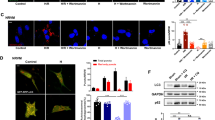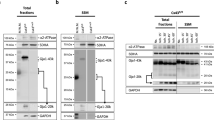Abstract
Phospholamban (PLB) is a sarcoplasmic reticulum (SR) protein that when phosphorylated at Ser16 by PKA and/or at Thr17 by CaMKII increases the affinity of the SR Ca2+ pump for Ca2+. PLB is therefore, a critical regulator of SR function, myocardial relaxation and myocardial contractility. The present study was undertaken to examine the status of PLB phosphorylation after ischemia and reperfusion and to provide evidence about the possible role of the phosphorylation of Thr17 PLB residue on the recovery of contractility and relaxation after a period of ischemia. Experiments were performed in Langendorff perfused hearts from Wistar rats. Hearts were submitted to a protocol of global normothermic ischemia and reperfusion. The results showed that (1) the phosphorylation of Ser16 and Thr17 residues of PLB increased at the end of the ischemia and the onset of reperfusion, respectively. The increase in Thr17 phosphorylation was associated with a recovery of relaxation to preischemic values. This recovery occurred in spite of the fact that contractility was depressed. (2) The reperfusion-induced increase in Thr17 phosphorylation was dependent on Ca2+ entry to the cardiac cell. This Ca2+ influx would mainly occur by the coupled activation of the Na+/H+ exchanger and the Na+/Ca2+ exchanger working in the reverse mode, since phosphorylation of Thr17 was decreased by inhibition of these exchangers and not affected by blockade of the L-type Ca2+ channels. (3) Specific inhibition of CaMKII by KN93 significantly decreased Thr17 phosphorylation. This decrease was associated with an impairment of myocardial relaxation. The present study suggests that the phosphorylation of Thr17 of PLB upon reflow, may favor the full recovery of relaxation after ischemia. (Mol Cell Biochem 263: 131–136, 2004)
Similar content being viewed by others
References
Brittsan A, Kranias EG: Phospholamban and cardiac contractile function. J Mol Cell Cardiol 32: 2131–2139, 2000
Suzuki T, Wang JH: Stimulation of bovine cardiac sarcoplasmic reticu-lum Ca 2 + pump and blocking of phospholamban phosphorylation and dephosphorylation by a phospholamban monoclonal antibody. J Biol Chem 261: 7018–7023, 1986
James P, Inui M, Tada M, Chiesi M, Carafoli E: Nature and site of phospholamban regulation of the Ca 2 + pump of sarcoplasmic reticulum. Nature 342: 90–92, 1989
Tada M, Toyofuku T: Molecular regulation of phospholamban function and expression. Trends Cardiovasc Med 8: 330–340, 1998
Lindemann JP, Watanabe AM: Phosphorylation of phospholamban in intact myocardium. Role of Ca 2 +-calmodulin-dependent mechanisms. J Biol Chem 260: 4516–4525, 1995
Mundiña-Weilenmann C, Vittone L, Ortale M, Chiappe de Cingolani, G, Mattiazzi, A: Immunodetection of phosphorylation sites gives new insights into the mechanisms underlying phospholamban phosphorylation in the intact heart. J Biol Chem 271: 33561–33567, 1996
Vittone L, Mundiña-Weilenmann C, Said M, Mattiazzi A: Mechanisms involved in the acidosis enhancement of the isoproterenol-induced phosphorylation of phospholamban in the intact heart. J Biol Chem 273: 9804–9811, 1998
Bartel S, Vetter D, Schlegel WP, Wallukat G, Krause EG, Karczewski P: Phosphorylation of phospholamban at threonine-17 in the absence and presence of ß-adrenergic stimulation in neonatal rat cardiomyocytes. J Mol Cell Cardiol 32: 2173–2185, 2000
Luo W, Grupp IL, Harrer J, Ponniah S, Grupp G, Duffy JJ, Doetschman T, Kranias EG: Targeted ablation of the phospholamban gene is as-sociated with markedly enhanced myocardial contractility and loss of β-agonist stimulation. Circ Res 75: 401–409, 1994
Luo W, Chu G, Sato Y, Zhou Z, Kadambi VJ, Kranias EG: Transgenic approaches to define the functional role of dual site phospholamban phosphorylation. J Biol Chem 273: 4734–4739, 1998
Chu G, Lester JW, Young KB, Luo W, Zhai J, Kranias EG: A single site (Ser 16 ) phosphorylation in phospholamban is sufficient in mediating its maximal cardiac responses to β-agonists. J Biol Chem 275: 38938–38943, 2000
Osada M, Netticadan T, Tamura K, Dhalla NS: Modification of ischemia-reperfusion-induced changes in cardiac sarcoplasmic reticulum by preconditioning. Am J Physiol 274: H2025–H2034, 1998
Netticadan T, Temsah R, Osada M, Dhalla NS: Status of Ca 2 +/ calmod-ulin protein kinase phosphorylation of cardiac SR proteins in ischemia-reperfusion. Am J Physiol 277: C384–C391, 1999
Lüss H, Meissner A, Rolf N, Van Aken H, Boknik P, Kirchhefer U, Knapp J, Läer S, Linck B, Lüss I, Müller F, Neumann J, Schmitz W: Biochemical mechanism(s) of stunning in conscious dogs. AmJ Physiol 279: H176–H184, 2000
Kim SJ, Kudej RK, Yatani A, Kim YK, Takagi G, Honda R, Colantonio DA, Van Eyk JE, Vatner DE, Rasmusson RL, Vatner SF: A novel mech-anism for myocardial stunning involving impaired Ca 2 + handling. Circ Res 89: 831–837, 2001
Vittone L, Mundiña-Weilenmann C, Said M, Ferrero P, Mattiazzi A: Time course and mechanisms of phosphorylation of phospholamban residues in ischemia-reperfused rat hearts. Dissociation of phospho-lamban phosphorylation pathways. J Mol Cell Cardiol 34: 39–50, 2002
Gao WD, Atar D, Liu Y, Pérez NG, Murphy A, Marb´ an E: Role of troponin I proteolysis in the pathogenesis of stunned myocardium. Circ Res 80: 393–399, 1997
Mundiña-Weilenmann C, Vittone L, Cingolani H, Orchard C: Effects of acidosis on phosphorylation of phospholamban and troponin I in rat cardiac muscle. Am J Physiol 270: C107–C114, 1996
Moor AN, Murtazina R, Fliegel L: Calcium and osmotic regulation of the Na+ /H+ exchanger in neonatal ventricular myocytes. J Mol Cell Cardiol 20: 185–197, 2000
Witcher DR, Kovacs RJ, Schulman H, Cefali DC, Jones LR: Unique phosphorylation site on the cardiac ryanodine receptor regulates calcium channel activity. J Biol Chem 266: 11144–11152, 1991
Xu A, Netticadan T, Jones DL, Narayanan N: Serine phosphorylation of the sarcoplasmic reticulum Ca 2 +-ATPase in the intact beating rabbit heart. Biochem Biophys Res Commun 264: 241–246, 1999
Author information
Authors and Affiliations
Rights and permissions
About this article
Cite this article
Mattiazzi, A., Mundiña-Weilenmann, C., Vittone, L. et al. Phosphorylation of phospholamban in ischemia-reperfusion injury: Functional role of Thr17 residue. Mol Cell Biochem 263, 131–136 (2004). https://doi.org/10.1023/B:MCBI.0000041854.72511.14
Issue Date:
DOI: https://doi.org/10.1023/B:MCBI.0000041854.72511.14




